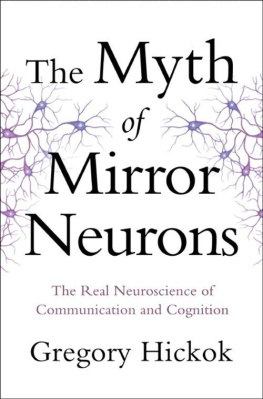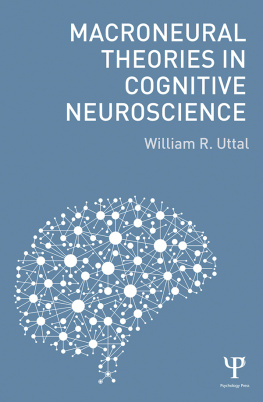Hickok - The Myth of Mirror Neurons: The Real Neuroscience of Communication and Cognition
Here you can read online Hickok - The Myth of Mirror Neurons: The Real Neuroscience of Communication and Cognition full text of the book (entire story) in english for free. Download pdf and epub, get meaning, cover and reviews about this ebook. year: 2014, publisher: W. W. Norton & Company, genre: Romance novel. Description of the work, (preface) as well as reviews are available. Best literature library LitArk.com created for fans of good reading and offers a wide selection of genres:
Romance novel
Science fiction
Adventure
Detective
Science
History
Home and family
Prose
Art
Politics
Computer
Non-fiction
Religion
Business
Children
Humor
Choose a favorite category and find really read worthwhile books. Enjoy immersion in the world of imagination, feel the emotions of the characters or learn something new for yourself, make an fascinating discovery.
- Book:The Myth of Mirror Neurons: The Real Neuroscience of Communication and Cognition
- Author:
- Publisher:W. W. Norton & Company
- Genre:
- Year:2014
- Rating:3 / 5
- Favourites:Add to favourites
- Your mark:
- 60
- 1
- 2
- 3
- 4
- 5
The Myth of Mirror Neurons: The Real Neuroscience of Communication and Cognition: summary, description and annotation
We offer to read an annotation, description, summary or preface (depends on what the author of the book "The Myth of Mirror Neurons: The Real Neuroscience of Communication and Cognition" wrote himself). If you haven't found the necessary information about the book — write in the comments, we will try to find it.
Hickok: author's other books
Who wrote The Myth of Mirror Neurons: The Real Neuroscience of Communication and Cognition? Find out the surname, the name of the author of the book and a list of all author's works by series.
The Myth of Mirror Neurons: The Real Neuroscience of Communication and Cognition — read online for free the complete book (whole text) full work
Below is the text of the book, divided by pages. System saving the place of the last page read, allows you to conveniently read the book "The Myth of Mirror Neurons: The Real Neuroscience of Communication and Cognition" online for free, without having to search again every time where you left off. Put a bookmark, and you can go to the page where you finished reading at any time.
Font size:
Interval:
Bookmark:
The Myth of
Mirror Neurons
The Real Neuroscience
of
Communication and Cognition

Gregory Hickok, PhD

W. W. NORTON & COMPANY
NEW YORK LONDON
To Krissy, for 30 years of
encouragement, support, and love
Contents
The Myth of
Mirror Neurons
T HE DISCOVERY and characterization of DNA in 1953 changed biology forever. DNA is the blueprint for life, the key to understanding how organisms are built, how they evolve, and how things can go wrong in disease.
In 2000, psychologist V.S. Ramachandran invoked the epochal impact of DNA in a prediction regarding a then recently discovered class of brain cells, mirror neurons:
I predict that mirror neurons will do for psychology what DNA did for biology: they will provide a unifying framework and help explain a host of mental abilities that have hitherto remained mysterious and inaccessible to experiments.
(Judging from the title of Ramachandrans TED talk on mirror neurons delivered in 2010, The Neurons that Shaped Civilization, a decade of intense research on the cells seems to have confirmed his predictions.)
In 2008, Marco Iacoboni, a neuroscientist at UCLA, echoed Ramachandrans enthusiasm for this class of brain cells:
We achieve our very subtle understanding of other people thanks to certain collections of special cells in the brain called mirror neurons. These are the tiny miracles that get us through the day. They are at the heart of how we navigate through our lives. They bind us with each other, mentally and emotionally.... Mirror neurons undoubtedly provide, for the first time in history, a plausible neurophysiological explanation for complex forms of social cognition and interaction.
Ramachandran and Iacoboni are not alone in their excitement. The scientific journals are full of mirror neuronbased explanations of human language, imitation, social perception, empathy, mind reading, music appreciation, art appreciation, spectator sports enjoyment, stuttering, and autism. A Wall Street Journal article in 2005 explained How Mirror Neurons Help Us to Empathize, Really Feel Others Pain; in the same year NOVA aired a program simply titled Mirror Neurons, and in 2006 The New York Times reported on them in an article titled Cells that Read Minds. Books and blogs tout the virtues of mirror neurons for everything from classroom education to your golf game. The extent of a human males erection has been claimed to be related to mirror neuron activity. If a recent news story is correct, even the Dalai Lama was enticed to visit UCLA to hear about the role of mirror neurons in cultivating compassion. Fitting for a class of cells sometimes called Dalai Lama neurons.
What are these miraculous human brain cells that can explain everything from erections to autism? Curiously, all of this speculation about human behavior does not find its foundation in human neuroscience research at all. Instead, the theoretical keystone is a class of cells found in the motor cortex of pigtail macaque monkeys, animals that cant talk, dont appreciate music, and, frankly, arent all that nice to each other. The behavior of mirror neurons is modest, at least in the context of the human abilities they are claimed to enable. The fundamental feature of these cells is that they respond (fire, as neuroscientists say) both when a monkey reaches for an object and when the monkey watches someone else reach for an object. Thats about it. From this simple response pattern neuroscientists and psychologists have built one of the most wide-reaching theories in the history of psychology for the neural basis of human behavior.
What is it about this apparently simple response pattern of mirror neurons in macaques that has excited an entire generation of scientists? How is it possible that a cell in the motor cortex of a monkey can provide the neural blueprint for human language, empathy, autism, and more? What are the logical building blocks that allow this inference?
The basic idea is simplethats its appeal. When a monkey reaches for an object, it understands its own action, what the goal is, why that particular goal is targeted, and so on. In short, the monkey knows what its doingand why. Thats the trivial part. But what enquiring monkey minds really want to know is what other monkeys are up to. Is he going to try to steal my food or is he just on his way to the watering hole? Thats rather harder to figure out. So the question is, how do you read (or understand) the actions of others? Mirror neurons provide a simple answer because they fire both when the monkey executes an action and when it observes similar actions executed by other monkeys: if the monkey understands the meaning of its own actions, then by simulating the actions of others in its own neuronal action system, it can, by the same token, understand the meaning of the actions of others.
Its an ingenious trickusing knowledge of self-actions to collect intelligence on the intentions of otherswith potential applications that extend well beyond the monkey lab. Given this starting point, the inferential steps from mirror neurons to human communication and cognition are not hard to imagine. Humans too need to read the intentions of other humans actions, so maybe they have a mirror system as well. Speech is an important human action; maybe a mirror neuronbased simulation mechanism underpins the crown jewel of human cognition: language. And sport is nothing if not action based; maybe we get so fanatical about our home team because mirror neurons put us right on the field, simulating every throw, catch, and kick. With humans its not just actions that we are capable of understanding. We understand others emotions and mental states; maybe there is a mirror-like mechanism behind empathy. Some disorders, like autism, are popularly thought to involve a lack of empathy; maybe autism results from broken mirror neurons. And mirror neuron theorizing comes with an evolutionary kicker: by showing a (previously missing) link between a monkey neuron that is involved in recognizing the actions of others and high-level human cognitive abilities, mirror neurons provide a toehold for a theory of the evolution of the human mind. Example: if mirror neurons in monkeys enable the understanding of simple gestural actions, such as grasping an object, then to start down the evolutionary path toward language all natural selection needs to do is hit on a way of broadening the scope of action understanding such that it includes actions related to vocalization, like monkey calls. The explanatory power of these deceptively simple cells appears impressive indeed.
Like many cognitive neuroscientists, I was intrigued by mirror neurons when I first learned about them in the 1990s. But I didnt get seriously interested in their properties and the hypotheses that swirled around them until the theoretical whirlwind kicked up dust in my own area of research. I study the neural basis of speech and language with a particular focus on speech perception and sensorimotor functions: How does the brain take a variable stream of air pressure waves (what hits your ears when you listen to speech) and convert it into recognizable sounds, words, sentences, and ideas? How do we learn to articulate the sounds of our language? Why do we talk with an accent when we learn a second language? Why does an echo of our own voice in a bad phone connection make it so hard to talk? Where does our inner voice come fromthe sense that we can hear our voice when we talk in our headsand what purpose does it serve? These are some of the questions I was (and remain) interested in answering.
Next pageFont size:
Interval:
Bookmark:
Similar books «The Myth of Mirror Neurons: The Real Neuroscience of Communication and Cognition»
Look at similar books to The Myth of Mirror Neurons: The Real Neuroscience of Communication and Cognition. We have selected literature similar in name and meaning in the hope of providing readers with more options to find new, interesting, not yet read works.
Discussion, reviews of the book The Myth of Mirror Neurons: The Real Neuroscience of Communication and Cognition and just readers' own opinions. Leave your comments, write what you think about the work, its meaning or the main characters. Specify what exactly you liked and what you didn't like, and why you think so.











